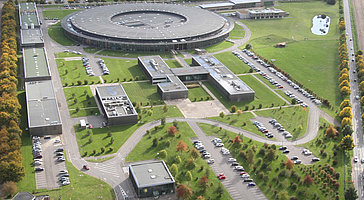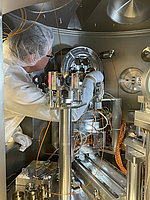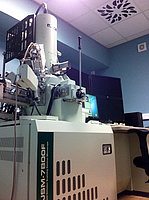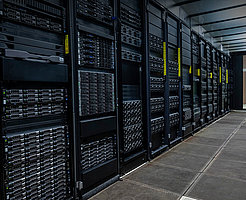(PMM) Physics of Materials and Molecules
The Physics of Materials and Molecules master track is a two-year program within the University of Lille's Master's in Fundamental Physics and Applications, with the option to enter in the first or second year. It is designed for students trained in fundamental physics or physical chemistry. The master's program aims to train students in an international scientific context, so it is taught in English.
Training objectives
The Physics of Materials and Molecules master track aims to train physicists to tackle the major scientific questions of the 21st century, from concrete and applied issues such as the design of new materials for the industry of tomorrow that are more compatible with today's environmental and energy challenges, to fundamental questions such as the behavior of matter within planets and atmospheres, methods of calculation at the atomic scale, and the use of large international research instruments.
The training is based on the knowledge and expertise of the following laboratories on the campus: UMET (Unité Matériaux et Transformations), PhLAM (Laboratoire de Physique des Lasers, Atomes et Molécules), IEMN (Institut d'Electronique, de Microélectronique et de Nanotechnologie) and LOA (Laboratoire d'Optique Atmosphérique).
Recruitment profiles
Students sought for entry into the first year will have a bachelor's degree in Fundamental Physics, a bachelor's degree in Physics-Chemistry, or equivalent. We also accept direct enrollment in the second year for students who can demonstrate completion of a first year of a master's program or a fourth year of higher education.
The enrollment procedures depend on your background and are described on the pages dedicated to first-year enrollment and second-year enrollment.
Solution Science - Discovery Science

The program is aimed at two types of students:
- students seeking solutions, who will be trained in the latest advances in materials science, enabling them to develop and exploit new materials, the latest analytical methods, and analytical tools to address today's societal issues (energy transition, energy efficiency, recycling, etc.) from the perspective of materials physics;
- students seeking discoveries, who will be able to draw on their training to understand the future of materials in various environments and conditions, from the heart of a nuclear power plant to polymers, metals, pharmaceutical materials, and even the interior of planets or the atmosphere.
Analytical methods and tools
During their studies, students will have the opportunity to learn
- how to use advanced characterization methods involving spectroscopy and diffraction, on high-level instruments such as the scanning and transmission electron microscopes at the Lille Electron Microscopy Platform;
- how to analyze data from experiments conducted on large research instruments or accelerators (the SOLEIL synchrotron, for example);
- not to mention the range of instruments available at partner laboratories.
They will also be trained in numerical methods for modeling matter, such as
- molecular dynamics;
- Hartree-Fock calculations;
- and density functional theory (DFT).
International
The program is part of the University of Lille's Graduate Program Materials for a Sustainable Future, which aims to train scientists to tackle the major challenges associated with the transitions currently underway through materials science. It is also associated with the Erasmus Mundus BIOPHAM program, which offers training in materials science dedicated to pharmaceutical applications and with which it shares approximately 50% of its courses.
In order to welcome students from all backgrounds and prepare them to work in a European and international context, the language of instruction is English. The teachers are French-speaking and able to answer questions and interact in French, but the courses are taught in English.
Skills acquired upon completion of the degree
Students on the Physics of Materials and Molecules track will become experts in a physics approach to materials and molecular science, with courses in advanced thermodynamics, solid-state physics, mechanical properties, and atomic and molecular physics. The targeted applications cover various fields such as metallic, ceramic, polymer, and engineered materials at the nanoscale, as well as molecules in a diluted state in the atmosphere or interstellar space.
They will be trained in advanced characterization methods such as X-ray diffraction, electron microscopy, and spectroscopy. They will also be trained in the possibilities offered by satellite remote sensing and other tools for studying the properties of matter and molecules, as well as the use of large instruments and accelerators such as synchrotrons and free-electron lasers.
The program also includes aspects of digital sciences. The first year offers general courses such as an introduction to artificial intelligence and machine learning and their uses in physics. Over the two years, students are also trained in digital methods specific to materials and molecular sciences, such as molecular dynamics calculations and those based on density functional theory (DFT).
Finally, students will have the opportunity to develop their general skills, communication skills, and professional skills through language classes, specialized project-based courses including oral and poster presentations, and long-term internships.
They will thus be prepared for doctoral studies and careers in research and development in industry or the public sector.
Program
The master's program is organized into two years and four semesters of 30 credits each, with classes and internships from September to June or July, for a total of 120 ECTS credits. In order to welcome students from all backgrounds and prepare them to work in a European and international context, the language of instruction is English. The majority of teachers are French-speaking and able to answer questions and interact in French, but classes are taught in English.
The courses are structured into three skill and knowledge blocks (BCC - Blocs de Compétences et Connaissances) described below.
Skill and knowledge blocks
Year 1 – Semester S1
- AI and advanced computational methods in physics – 3 ECTS
Explore the intersection of AI, Machine Learning, and Physics in this class. Gain hands-on experience with cutting-edge techniques and applications tailored for the world of physics. - Atomic scale modeling I – 3 ECTS
Discover powerful simulation techniques like Molecular Dynamics and Monte Carlo to predict and design material properties at the atomic scale. - States of Matter and Materials Science Primers – 3 ECTS
Have a clear understanding of the different families of materials (metals and alloys, ceramics, polymers) based on their properties and microstructure.
Year 1 – Semester S2
- Satellites and remote sensing – 3 ECTS
Master the principles and applications of remote sensing and satellite technology through comprehensive lectures and practical work with insights into environmental monitoring and cutting edge research. - Radiative transfer and radiation-matter interactions – 3 ECTS
Master the principles and applications of radiation-matter interaction in the context of atmospheric studies. Through a good balance between theoretical, numerical and practical elements. - Large scale research infrastructures – 3 ECTS
This course aims to introduce students to the principles, functioning, and applications of major large scale research infrastructures (LSRI) used in both fundamental and applied research.
Year 2 – Semester S3
- Structural properties of matter : electron microscopy and diffraction – 3 ECTS
Characterize the state of materials at the crystal to nanometer scale using advanced experimental methods such as the scanning and transmission electron microscope, and powder X-ray diffraction - Atomic scale modeling II – 3 ECTS
Discover quantum first principles methods to solve the problem of the electronic structure of molecular systems, from isolated molecules to solids - Advanced Spectroscopy of Molecular Systems: From Gas Phase to Condensed Matter (ASMS) – 3 ECTS
This course aims to introduce fundamental principles in molecular physics characterization by optical (vibrational, rotational) and neutron spectroscopies, as well as dielectric techniques.
Year 1 – Semester S1
- Foreign language (French or English) – 3 ECTS
Improve your communication skills in a foreign language - PE or Graduate Program Special Teaching – 3 ECTS
Learn on current topic from the Materials for a Sustainable Future graduate program - Tutored trainings – 3 ECTS
Discover new topics in physics based on the scientific literature, and develop your teaching and presentation skills in front of your peers.
Year 1 – Semester S2
- Tutored trainings – 3 ECTS
Discover new topics in physics based on the scientific literature, and develop your teaching and presentation skills in front of your peers. - Experimental project – 3 ECTS
Develop students’ autonomy, scientific rigor, and technical skills through the realization of an experimental project in pairs. Apply theoretical knowledge acquired so far to solve a real-world problem. - Internship – 6 ECTS
A two-month-long experience in a professional working environment
Year 2 – Semester S3
- Foreign language (French or English) – 3 ECTS
Improve your communication skills in a foreign language - Specialty (pick 3 out of 5 – 2 ECTS each):
- Materials under extreme conditions: fundamentals in state of matter under extreme pressure and temperatures with applications in condensed matter, materials, and planetary sciences.
- Metals and alloys: discover elements of research in physical metallurgy, from fundamental research to real world applications.
- Polymers: Gain insights into the structure-property relationships of polymer materials and understand essential characterization and processing techniques. Learn to select the polymer in relation to use properties.
- Mathematical crystallography: mathematical formalism to discover relationships between planes and directions, symmetry operations, coordinate transformations, and conversions from direct to reciprocal space.
- Instrumentation in spectroscopy: fundamentals of spectroscopy, instrumentations, and relations to the domain of relevance (environmental sciences, astrophysics, energy, human health, drug design, fundamental physics, etc.).
Year 2 – Semester S4
- PE or Graduate Program Special Teaching – 3 ECTS
Learn on current topic from the Materials for a Sustainable Future graduate program - Internship – 27 ECTS
A five-month-long experience in a professional working environment
Year 1 – Semester S1
- Continuum mechanics – 3 ECTS
Introduction to the principles of stress, strain, anisotropic and isotropic elasticity with applications covering a broad area relating to the mechanical behavior of materials. - Statistical physics and critical phenomena – 3 ECTS
Fundamental concepts in statistical physics, focusing on Bose-Einstein and Fermi-Dirac statistics, phase transitions, critical phenomena, and the renormalization group. - Condensed matter I – Electrons – 3 ECTS
Basics on electronic properties in solid state physics, covering equilibrium and transport properties of crystalline solids, from the Sommerfeld model to semi-conductors. - Atomic physics – 3 ECTS
Explore the quantum mechanical description of both single and multi-electron atoms, gain a deeper understanding of the periodic table's structure, and investigate how atoms interact with light and how their spectra provide insights into these systems.
Year 1 – Semester S2
- Condensed Matter II – Phonons – 3 ECTS
This lecture explores the vibrational properties of crystalline solids, from lattice symmetries and phonon dispersion to thermodynamic behavior. It provides the fundamental tools to understand heat capacity, thermal transport, and the quantum nature of lattice vibrations in condensed matter systems. - Fundamentals of molecular spectroscopy – 3 ECTS
Gain a solid understanding of the quantum mechanical principles behind molecular spectroscopy, with emphasis on rotational and vibrational transitions and the role of symmetry in determining spectroscopic activity. - Microstructures and defects in materials – 3 ECTS
Discover how grains, defects, and other microstructural elements and how they control the physical properties of materials.
Year 2 – Semester S3
- Advanced thermodynamics and phase transformations – 3 ECTS
This course explores the principles governing crystalline and amorphous physical states and their transformations across diverse materials like metallic alloys, glasses, and polymers. - Molecular mobility and amorphous state of matter – 3 ECTS
This course presents the characteristics of molecular motions found in amorphous materials in the supercooled and glassy states, and the temperature dependence of these dynamics. - From macro to nanophysics – 3 ECTS
Introduce the physics of nanomaterials, and show how optical / electromagnetic / thermal / mechanical properties are modified from macroscopic to the nanometer scale. - Materials plasticity – 3 ECTS
Physical basis of plasticity of crystalline solids, from the elementary mechanisms to the plastic behavior in various conditions.
Syllabus
You will find details of the course content in the following detailed syllabus.
First year master program
The first year is divided into two semesters, with classes
- from September to December for the first semester;
- from January to the end of April for the second semester;
- a two-month internship in May and June (which may be extended into July and August).
The program is based on traditional teaching in the form of lectures and tutorials, project-based teaching, and practical work, both digital and instrumental.
Some of the courses are shared with the Quantum and Photonic Technologies (QPT), Advanced Physics of Pharmaceutical Materials (A2PM), and Erasmus Mundus BIOPHAM programs.
List of courses (year 1)
BCC1 : Implementing fundamental physics tools and approaches to produce highly specialized knowledge – 9 ECTS
- AI and advanced computational methods in physics – 3 ECTS
Explore the intersection of AI, Machine Learning, and Physics in this class. Gain hands-on experience with cutting-edge techniques and applications tailored for the world of physics. - Atomic scale modeling I – 3 ECTS
Discover powerful simulation techniques like Molecular Dynamics and Monte Carlo to predict and design material properties at the atomic scale. - States of Matter and Materials Science Primers – 3 ECTS
Have a clear understanding of the different families of materials (metals and alloys, ceramics, polymers) based on their properties and microstructure.
BCC2 : Producing and communicating highly specialized knowledge, including in a professional context – 9 ECTS
- Foreign language (French or English) – 3 ECTS
Improve your communication skills in a foreign language - PE or Graduate Program Special Teaching – 3 ECTS
Learn on current topic from the Materials for a Sustainable Future graduate program - Tutored trainings – 3 ECTS
Discover new topics in physics based on the scientific literature, and develop your teaching and presentation skills in front of your peers.
BCC3 : Solving complex problems by applying fundamental physics concepts – 12 ECTS
- Continuum mechanics – 3 ECTS
Introduction to the principles of stress, strain, anisotropic and isotropic elasticity with applications covering a broad area relating to the mechanical behavior of materials. - Statistical physics and critical phenomena – 3 ECTS
Fundamental concepts in statistical physics, focusing on Bose-Einstein and Fermi-Dirac statistics, phase transitions, critical phenomena, and the renormalization group. - Condensed matter I – Electrons – 3 ECTS
Basics on electronic properties in solid state physics, covering equilibrium and transport properties of crystalline solids, from the Sommerfeld model to semi-conductors. - Atomic physics – 3 ECTS
Explore the quantum mechanical description of both single and multi-electron atoms, gain a deeper understanding of the periodic table's structure, and investigate how atoms interact with light and how their spectra provide insights into these systems.
BCC1 : Implementing fundamental physics tools and approaches to produce highly specialized knowledge – 9 ECTS
- Satellites and remote sensing – 3 ECTS
Master the principles and applications of remote sensing and satellite technology through comprehensive lectures and practical work with insights into environmental monitoring and cutting edge research. - Radiative transfer and radiation-matter interactions – 3 ECTS
Master the principles and applications of radiation-matter interaction in the context of atmospheric studies. Through a good balance between theoretical, numerical and practical elements. - Large scale research infrastructures – 3 ECTS
This course aims to introduce students to the principles, functioning, and applications of major large scale research infrastructures (LSRI) used in both fundamental and applied research.
BCC2 : Producing and communicating highly specialized knowledge, including in a professional context – 12 ECTS
- Tutored trainings – 3 ECTS
Discover new topics in physics based on the scientific literature, and develop your teaching and presentation skills in front of your peers. - Experimental project – 3 ECTS
Develop students’ autonomy, scientific rigor, and technical skills through the realization of an experimental project in pairs. Apply theoretical knowledge acquired so far to solve a real-world problem. - Internship – 6 ECTS
A two-month-long experience in a professional working environment
BCC3 : Solving complex problems by applying fundamental physics concepts – 9 ECTS
- Condensed Matter II – Phonons – 3 ECTS
This lecture explores the vibrational properties of crystalline solids, from lattice symmetries and phonon dispersion to thermodynamic behavior. It provides the fundamental tools to understand heat capacity, thermal transport, and the quantum nature of lattice vibrations in condensed matter systems. - Fundamentals of molecular spectroscopy – 3 ECTS
Gain a solid understanding of the quantum mechanical principles behind molecular spectroscopy, with emphasis on rotational and vibrational transitions and the role of symmetry in determining spectroscopic activity. - Microstructures and defects in materials – 3 ECTS
Discover how grains, defects, and other microstructural elements and how they control the physical properties of materials.
Syllabus
You will find details of the course content in the following detailed syllabus.
Second year master program
The second year is divided into two semesters, with
- classes from September to January;
- a five-month internship starting at the end of January and ending at the end of June (which can be extended into July and August but not be longer than 6 months).
As in the first year, the program is based on traditional teaching in the form of lectures and tutorials, project-based teaching, and practical work, both digital and instrumental. Students also have the opportunity to work directly on research equipment, such as spectrometers and electron microscopes.
Some courses are shared with the Advanced Physics of Pharmaceutical Materials (A2PM) program and the Erasmus Mundus BIOPHAM program.
Details of the courses for each semester and their distribution into skill and knowledge blocks and teaching units are described below.
List of courses (year 2)
BCC1 : Implementing fundamental physics tools and approaches to produce highly specialized knowledge – 9 ECTS
- Structural properties of matter : electron microscopy and diffraction – 3 ECTS
Characterize the state of materials at the crystal to nanometer scale using advanced experimental methods such as the scanning and transmission electron microscope, and powder X-ray diffraction - Atomic scale modeling II – 3 ECTS
Discover quantum first principles methods to solve the problem of the electronic structure of molecular systems, from isolated molecules to solids - Advanced Spectroscopy of Molecular Systems: From Gas Phase to Condensed Matter (ASMS) – 3 ECTS
This course aims to introduce fundamental principles in molecular physics characterization by optical (vibrational, rotational) and neutron spectroscopies, as well as dielectric techniques.
BCC2 : Producing and communicating highly specialized knowledge, including in a professional context – 9 ECTS
- Foreign language (French or English) – 3 ECTS
Improve your communication skills in a foreign language - Specialty (pick 3 out of 5 – 2 ECTS each):
- Materials under extreme conditions: fundamentals in state of matter under extreme pressure and temperatures with applications in condensed matter, materials, and planetary sciences.
- Metals and alloys: discover elements of research in physical metallurgy, from fundamental research to real world applications.
- Polymers: Gain insights into the structure-property relationships of polymer materials and understand essential characterization and processing techniques. Learn to select the polymer in relation to use properties.
- Mathematical crystallography: mathematical formalism to discover relationships between planes and directions, symmetry operations, coordinate transformations, and conversions from direct to reciprocal space.
- Instrumentation in spectroscopy: fundamentals of spectroscopy, instrumentations, and relations to the domain of relevance (environmental sciences, astrophysics, energy, human health, drug design, fundamental physics, etc.).
BCC3 : Solving complex problems by applying fundamental physics concepts – 12 ECTS
- Advanced thermodynamics and phase transformations – 3 ECTS
This course explores the principles governing crystalline and amorphous physical states and their transformations across diverse materials like metallic alloys, glasses, and polymers. - Molecular mobility and amorphous state of matter – 3 ECTS
This course presents the characteristics of molecular motions found in amorphous materials in the supercooled and glassy states, and the temperature dependence of these dynamics. - From macro to nanophysics – 3 ECTS
Introduce the physics of nanomaterials, and show how optical / electromagnetic / thermal / mechanical properties are modified from macroscopic to the nanometer scale. - Materials plasticity – 3 ECTS
Physical basis of plasticity of crystalline solids, from the elementary mechanisms to the plastic behavior in various conditions.
BCC2 : Producing and communicating highly specialized knowledge, including in a professional context – 12 ECTS
- PE or Graduate Program Special Teaching – 3 ECTS
Learn on current topic from the Materials for a Sustainable Future graduate program - Internship – 27 ECTS
A five-month-long experience in a professional working environment
Syllabus
You will find details of the course content in the following detailed syllabus.
Jobs and careers
The Physics of Materials and Molecules master track enables recruitment in public or private research laboratories (large corporations, SMEs, mid-sized companies, start-ups, EPICs) in one of the many fields covered by the program. It is possible to enter the workforce directly after graduation or after further studies and a doctorate.
The data below is based on statistics compiled from approximately 60 students who have completed this program or its predecessors. It provides a clear and well-documented picture of the future prospects of students who have completed the program.
PhD theses
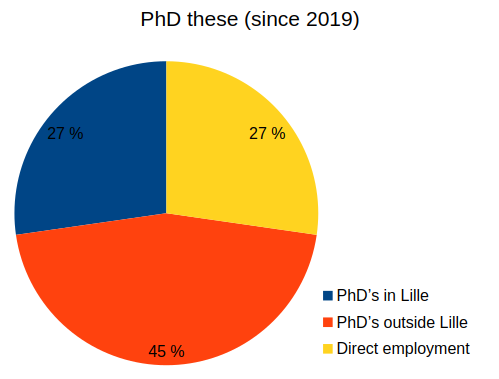
After the master's degree, approximately 75% of students since 2019 have continued towards a PhD. The others have gone for a direct employment.
Employment and activity sectors
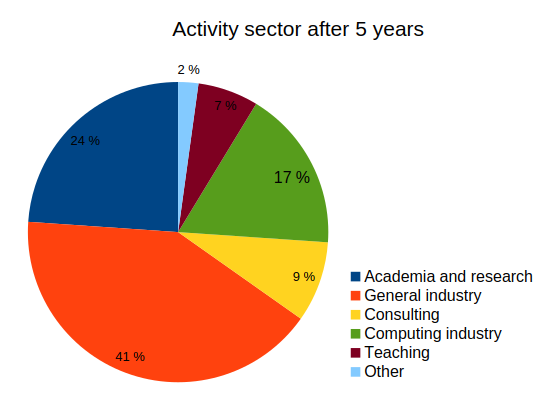
Above are statistics on ~60 students, 5 years or more after their master's degree :
- 24 % are in academia or public research organizations such as CNRS, Yale and Phœnix universities (USA), the universities of Tours, Lille or Grenoble INP in France, the Universitas 17 Agustus 1945 Surabaya in Indonesia, the Canadian Nuclear Laboratories, the CEA (French Alternative Energies and Atomic Energy Commission), the Onera (French Aerospace Lab), or the Université Libre de Bruxelles ;
- 41 % work in industry: Siemens Energy, Framatome, EDF, Décathlon, Altsom, Raclot Industries, AstraZeneca, Imerys, Groupe Institut de Soudure, ITP Interpipe, Blue Capsule Technology, PPG ;
- 9 % work in consulting and 17 % in the digital industry : Devoteam G Cloud, Sopra HR Software, Sopra Banking Software, Groupe Luminess, Axecom, Calogena, DEF, Assystem, Power Inside Data ;
- high school education : 7 % ;
- other : 2 %.
Following their doctoral theses, a number of students go on to work in R&D activities in large public organizations (CEA, Onera, universities, etc.) as well as in the private sector (EDF, Framatome, Siemens, etc.), while others move into consulting or the digital industry.
Positions
Some examples of positions held by former students:
- R&D Manager, Racot Industries
- Fire Satety and EcoDesign Engineer, Alstom
- Ingérnieur produits, Décathlon
- Maître de conférences, Université de Tours
- Enseignant, Education Nationale
- Clinical Trial Associate, Aquilab
- Computational research scientist, Canadian Nuclear Laboratories
- Data scientist, Siemens,
- Senior research scientist, Univ. Yale
- Cloud infrastructure architect, Devoteam
- Chargé de recherches, CNRS
- Head of physics laboratory, Indonesia
- Ingénieur d'études, Grenoble INP
- Ingénieur innovation, ITP Interpipe
- Senior scientist, Astra Zenecca
- Ingénieur systèmes, Alstom
- Consulting Engineer, Prodigyus
- Ingénieur accidents grave, Framatome
- Ingénieur, EDF
- Responsable produits, Groupe Institut Soudures
- Research Engineer, Onera
- Physics faculty, Phoenix University
- Ingénieur matériaux et modélisations, Blue capsule technology
- Ingénieur de recherches, CNRS
- Technical lead, Nuclear AMRC
- Industrial Project Manager, Imerys
Research examples
Below are examples of works published in the scientific literature by some of our former students. The topics range from the stability of pharmaceutical materials to meteorites, and also include works on materials irradiated inside a nuclear reactor, the synthesis of new polymers made from starch, the development of new advanced experimental techniques, materials for energy storage, or the mechanical properties of the Earth's deep mantle.
Prussian Blue Analog nanocrystals are nano-objects at the frontier between molecules and bulk materials and have molecular properties that can be used for different applications such as gas storage materials for energy issues, magnetic properties for information storage, electrochemical and biosensors, catalysis, environmental purification, or biomedical applications. This work is a study of the electron transport properties at the nanoscale of individual Prussian Blue Analog cubic nanocrystals. The conductivity values measured on individual nanocrystals are up to fifty times higher than those reported on PBA films.
Full publication : H. Therssen, L. Catala, S. Mazérat, T. Mallah, D. Vuillaume, T. Mélin & S. Lenfant. Electronic properties of single Prussian Blue Analog nanocrystals determined by conductive-AFM (2023) Nanoscale 15 19128-19138 [doi: 10.1039/d3nr04542k]
Drug solubility and bioavailability are the most important formulation challenges in pharmaceutical development, probably because a major part of the active pharmaceutical ingredients (APIs) are synthesized in the crystalline state which is often a poorly water-soluble state. Mesoporous silica carriers have recently gained interest in the pharmaceutical domain because of their potential to significantly increase the solubility of poorly water-soluble drugs, by adsorbing the active molecule in an amorphous and relatively stable state. This work shows that co-milling of porous SBA-15 matrix with the drug makes it possible the drug loading without significant damage for the structure of the matrix, enhancing thereby the capacity of loading to almost 40 wt%. It is shown that the physical state of ibuprofen (IBP) confined to silica carriers was amorphous between temperatures Tg and Tm of the bulk form of IBP.
Full publication : B. Malfait, N. Correia, A. Mussi, L. Paccou, Y. Guinet & A. Hédoux. Solid-state loading of organic molecular materials within mesoporous silica matrix: Application to ibuprofen (2019) Microporous and Mesoporous Materials 277 203-207 [doi: 10.1016/j.micromeso.2018.10.022]
Silicate glasses usually refer to amorphous materials in which SiO2 forms a network of corner-sharing tetrahedra. These vitreous phases can further incorporate different cations leading to the well-known categories of borosilicate glasses, aluminosilicate glasses or soda-lime glasses. This paper reports an initial investigation of the rheology of Mg2SiO4 glass through classical molecular dynamics simulations. The goal of the present study is therefore to analyse the mechanical response and rheological behaviour of an olivine glass of forsterite composition Mg2SiO4 and to elucidate how local atomic rearrangements evolve in the deformation process at low temperature.
Full publication : V. Delbecq, P. Carrez & P. Cordier. Rheological properties of Mg2SiO4 glass: A molecular dynamics study (2023) Journal of Non-Crystalline Solids 619 122572 [doi: 10.1016/j.jnoncrysol.2023.122572]
The plastic deformation of materials comes from the ability of crystal lattices to shear through the movements of dislocations. The interactions of the different mechanisms of deformation are complex and depend on each other. Their understanding is necessary, and a precise observation of these phenomena must be performed in order to take them into account when building theoretical models at the microstructural scale. This study is dedicated to the determination of the best methodology to apply for the characterization of dislocation densities that can be used as input in micro-mechanical modellings.
Full publication : J. Gallet, M. Perez, R. Guillou, C. Ernould, C. Le Bourlot, C. Langlois, B. Beausir, E. Bouzy, T. Chaise & S. Cazottes. Experimental measurement of dislocation density in metallic materials: A quantitative comparison between measurements techniques (XRD, R-ECCI, HR-EBSD, TEM) (2023) Materials Characterization 199 112842 [doi: 10.1016/j.matchar.2023.112842]
Materials systems subjected to external forcing are often observed to self-organize into patterns. Instabilities arise in these systems that can trigger the formation of transient structures, which then evolve into metastable or even stable steady-state patterns. Such patterns have been reported in solids and alloys subjected to irradiation and to severe plastic deformation, resulting in microstructures with emergent pattern length scales and symmetry. Using a simple model for point defect and chemical transport in an irradiated alloy, along with phase field simulations, this work reports on a novel compositional patterning phenomenon at grain boundaries and show that it results from solute advection to grain boundaries coupled with anisotropic solute diffusion at grain boundaries.
Full publication : G. F. Bouobda Moladje, R. S. Averback, P. Bellon & L. Thuinet. Convection-Induced Compositional Patterning at Grain Boundaries in Irradiated Alloys (2023) Physical Review Letters 131 056201 [doi: 10.1103/physrevlett.131.056201]
Sensing with terahertz (THz) radiations (100 GHz−10 THz, λ: 3 mm−30 μm) has demonstrated valuable purposes, e.g., for the uncovering of hidden items or the detection of relevant chemical and biochemical compounds. These works investigated the near-field distribution associated to the photonic mode of terahertz photonic micro-resonators by scattering scanning near-field optical microscopy and propose a scenario based on the combination of the near-field with the far-field pattern of the probe/resonator ensemble that is in excellent agreement with the experimental data and propose an image analysis procedure to recover the near-field of such structures.
Full publication : L. Thomas, T. Hannotte, C. N. Santos, B. Walter, M. Lavancier, S. Eliet, M. Faucher, J.-F. Lampin & R. Peretti. Imaging of THz Photonic Modes by Scattering Scanning Near-Field Optical Microscopy (2022) ACS Applied Materials & Interfaces 14 32608-32617 [doi: 10.1021/acsami.2c01871]
The ability of complex parts production directly from a computer aided design without machining or assembling step has increased the interests in Additive Manufacturing. Laser powder bed fusion, largely employed for additive manufacturing, induces after each batch a large quantity of remaining powder. This study focuses on the possibility to reuse this remaining powder after a large number of production cycles and on the influence of such reusing on the microstructure and mechanical properties.
Full publication : E. Paccou, M. Mokhtari, C. Keller, J. Nguejio, W. Lefebvre, X. Sauvage, S. Boileau, P. Babillot, P. Bernard & E. Bauster. Investigations of powder reusing on microstructure and mechanical properties of Inconel 718 obtained by additive manufacturing (2021) Materials Science and Engineering: A 828 142113 [doi: 10.1016/j.msea.2021.142113]
Considering the exhaustion of petroleum resources and consumer request for sustainable products, starch is one of the most inexpensive and readily available bio-based polymer that has attracted a great deal of interest as potential alternative to conventional plastics for packaging applications. Here, the structure-property relationships of almost fully substituted fatty acid starch esters are investigated as a function of both fatty acid chain length and amylose/amylopectin ratio of the starch. The structural study has revealed a layered type organization in which starch chain planes are separated by fatty chains. The latter are interpenetrated and/or tilted for FASE-C16 whatever the origin of the starch is, and fatty chains partially crystallizes into a structure with hexagonal symmetry.
Full publication : A. Vanmarcke, L. Leroy, G. Stoclet, L. Duchatel-Crépy, J.-M. Lefebvre, N. Joly & V. Gaucher. Influence of fatty chain length and starch composition on structure and properties of fully substituted fatty acid starch esters (2017) Carbohydrate Polymers 164 249-257 [doi: 10.1016/j.carbpol.2017.02.013]
Chemical zoning in olivines is frequently found in unequilibrated chondrites, both in carbonaceous chondrites and ordinary chondrites meteorites. This work uses analytical transmission electron microscopy to study the microstructure of the fayalite-rich matrix grains and interfaces with forsterite fragments within samples of the Allende meteorite. The analyses suggest that the composition profiles were formed by solid-state diffusion during the thermal metamorphism episode. Time–temperature couples associated with the diffusion process during thermal metamorphism are deduced from profile modeling. Considering the uncertainties on the diffusion coefficient value, the work shows that the peak temperature experienced by the Allende meteorite is ranging from 425 to 505 °C.
Full publication : P. Cuvillier, H. Leroux, D. Jacob & P. Hirel. Fe‐Mg interdiffusion profiles in rimmed forsterite grains in the Allende matrix: Time–temperature constraints for the parent body metamorphism (2015) Meteoritics & Planetary Science 50 1529-1545 [doi: 10.1111/maps.12493]
Mantle convection is elusive at human timescale since it operates over hundreds of million years. Seismic anisotropy, which samples the direction-dependence of elastic wave propagation, represents one of the potential observables of past convection since it is an indicator of flow patterns in the deep Earth through the development of crystal preferred orientations. This work aims to determine the efficiency of dislocation glide in the pure MgSiO3 end-member bridgmanite at conditions relevant to the lower mantle by relying on atomic scale calculations to model dislocation glide at high-pressure and temperature. The work shows that in the lower mantle, bridgmanite would always be in the thermally activated regime and that stresses close to 1 GPa are still necessary to move dislocations in bridgmanite. In the uppermost lower mantle, dislocation glide is inhibited and other deformation mechanisms, involving diffusion, are needed.
Full publication : A. Kraych, P. Carrez & P. Cordier. On dislocation glide in MgSiO 3 bridgmanite at high-pressure and high-temperature (2016) Earth Planet. Sci. Lett. 452 60-68 [doi: 10.1016/j.epsl.2016.07.035]
Scholarships and funding opportunities
Graduate program at Univ. Lille
The Graduate Programs at the University of Lille offer scholarships with the aim of attracting exceptionally talented students to their master's programs. These scholarships not only reward academic excellence, but also aim to promote a diverse and dynamic academic community. In 2025, they were worth €8,500 for incoming international students enrolling for the first time in a French higher education institution and €4,500 for French students, international students already in France, and those extending their scholarship for a second year as part of a Master's degree in the Graduate Program.
For the 2025 academic year, the timelines were as follows
| Call | Applications | Results |
| #1 | 1 February - 15 March | 15 April |
| #2 | 1 April - 15 May | 15 June |
Mobilex fellowships
Another possibility will be support from the Mobilex program at the University of Lille, upon recommendation by the director of studies. Candidates are picked through partnerships or among the applicants of the "Etudes in France" program. Applications are processed in the spring, for a fellowship starting in September.
Excellence Eiffel Scholarship Program
Developed by the Ministry of Foreign Affairs, the France Excellence Eiffel Scholarship Program provides annual training for future foreign decision-makers in the public and private sectors in degree programs at the Master's and Doctoral levels. Applications are submitted exclusively by French higher education institutions.
France Excellence Eiffel scholarship holders receive a monthly allowance of €1,200 (from January 2026), to which is added several services: International transportation, national transportation, insurance, housing searches, cultural activities, etc.
Applicants should contact the Campus France in their country of origin or the French Embassy's Cooperation and Cultural Action Department, who can guide them and advise you on your study plans. They should then contact the director of studies of the master program who can support their application inside the University.
See more details on the France Excellence Eiffel Scholarship Program.
Application deadline to the director of studies is in early November, for a fellowship starting in September of the following year.

